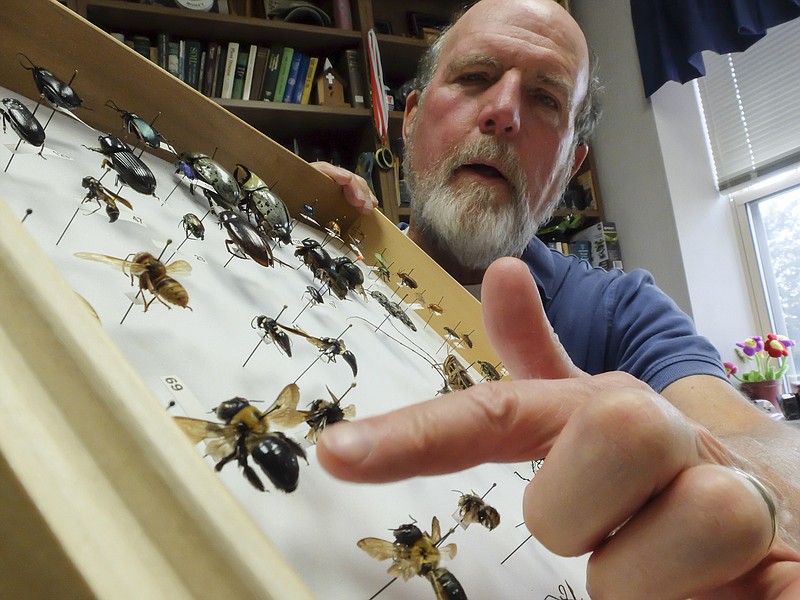With warmer temperatures and longer days come bugs. With bugs comes the task of keeping them out of your home.
In most cases, pesticides only superficially treat the problem. Hamilton County Extension Agent Thomas Stebbins has a better solution: Seal all cracks and crevices so bugs can't get in.
Try this
Bugs seem to come from no where during spring and summer months. Here are some of the most common and ways to get rid of them1. Roaches: Find where the roaches are coming in and sprinkle that area with boric acid. Roaches eat it and die.2. Ladybugs: Vacuum them up and release them back outside. Make sure windows and doors have no holes that need patching.3. Spiders: A solution of water and vinegar knocks them out. Spiders can’t handle the acid in vinegar.4. Ants: Sprinkle salt around loose windows or any place where they may come in. Also cinnamon blocks ants.5. Stink Bugs: Spraying them with a mixture of soap and water gets rid of them. They crawl away and eventually die.6. Carpenter Bees: Spray boric acid in the entry holes of the nest to kill larvae before they hatch.Source: www.homeremedyhacks.com and www.thestir.cafemom.com
"Instead of putting your money into sprays, put your money into caulking," he says.
Bugs enter a home when they see light shining from around doorways and window sills. Caulk those cracks. Attach a sweep to the bottom of the door to create a better seal between the door and the floor, he says.
Keeping a tight home improves energy efficiency and alleviates most seasonal bugs without chemical pesticides.
Arrow Exterminators, a local pest and termite control company, also recommends making sure all screens on doors and windows are in good repair and all exterior cracks and crevices are sealed.
The company also suggests that homeowners check themselves and their personal belonging for bugs before entering their home.
Bugs of spring include boxelder bugs, crane flies, Asian lady beetles and carpenter bees.
They can damage clothing, furniture and other fabrics with their droppings.
And true to their name, stink bugs stink.
"While they don't transmit diseases, bite or sting, these stinky pests do emit a strong odor when frightened, disturbed or squashed," according to an Arrow Exterminators news release about stink bugs.
While not as pungent as stink bugs, boxelder bugs also can give off an odor.
All of the insects can be a nuisance, but most of them are helpful pollinators, says Stebbins.
The bugs that people see right now are called boxelder bugs. They usually come in homes near trees. They reproduce under leaves when people rake them and leave them on their lawns. And when it gets cold, they hunker down until spring. Then they end up on the sunny part of people's homes.
One remedy is to take a broom and just sweep them out, says Stebbins.
Some people vacuum them, but they stink up the vacuum a little bit, he says.
They won't live long if left alone in the house because it's too dry for them.
"They usually don't last more than a day or two, but that's enough to make us wish we didn't have them in there," says Stebbins.
None of the bugs bite. The lady beetle pinches, but most people don't even feel it.
Only female carpenter bees have a stinger, and they don't use it unless provoked. Male bees fly right in front of a person's face when they get close to his nest, in an effort to scare the "predator."
Carpenter bees are a problem, though, because they make their nest by making holes in wooden structures, such as decks or houses.
People can get rid of them by caulking up the holes they make. Left unattended, the bees will lay eggs in the hole and cover them with dirt, which will lead to more bees hatching and eventually making more holes.
They holes are usually the size of a pinky finger, and it's usually not enough to destroy a home or deck, says Stebbins.
The only insect for which Stebbins recommends a professional exterminator with pesticides is termites. They can destroy a home, he says.
This is a good time to check for them because this is the time of year they may be swarming. They don't have wings all year, not when they're actually eating the wood on a house. But this time of year, you may see them swarming around areas of the home. Seeing them means they're probably in a crawl space or the basement. So call an exterminator.
Many pest control companies offer free inspections, so that homeowners can see the problems and learn preventive measures to take.
Contact Yolanda Putman at yputman@timesfreepress.com or 423-757-6431.
